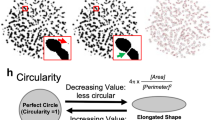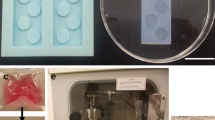Abstract
High-density micromass cultures of embryonic mesenchymal cells have proved to be an invaluable model for studying the entire chondrogenic program, from precartilaginous condensations through to chondrocyte hypertrophy. This culture model also provides a powerful system in which to explore the function of various factors in the commitment and differentiation of mesenchymal cells to the chondrogenic lineage. In this regard, micromass cultures provide a consistent and robust model for investigating the effects of genetic manipulations on skeletal phenotypes and for delineating their molecular basis. In this methods chapter, the derivation and use of micromass cultures from murine limb buds are described, but these techniques are also applicable to other organisms and mesenchymal cell sources.
Access this chapter
Tax calculation will be finalised at checkout
Purchases are for personal use only
Similar content being viewed by others
References
Hall BK, Miyake T (2000) All for one and one for all: condensations and the initiation of skeletal development. Bioessays 22:138–147
Daniels K, Reiter R, Solursh M (1996) Micromass cultures of limb and other mesenchyme. Methods Cell Biol 51:237–247
Niswander L (2008) Methods in avian embryology experimental and molecular manipulation of the embryonic chick limb. Methods Cell Biol 87:135–152
Barna M, Niswander L (2007) Visualization of cartilage formation: insight into cellular properties of skeletal progenitors and chondrodysplasia syndromes. Dev Cell 12:931–941
Dranse HJ, Sampaio AV, Petkovich M et al (2011) Genetic deletion of Cyp26b1 negatively impacts limb skeletogenesis by inhibiting chondrogenesis. J Cell Sci 124:2723–2734
Hoffman LM, Garcha K, Karamboulas K et al (2006) BMP action in skeletogenesis involves attenuation of retinoid signaling. J Cell Biol 174:101–113
Karamboulas K, Dranse HJ, Underhill TM (2010) Regulation of BMP-dependent chondrogenesis in early limb mesenchyme by TGFbeta signals. J Cell Sci 123:2068–2076
Lorda-Diez CI, Montero JA, Martinez-Cue C et al (2009) Transforming growth factors beta coordinate cartilage and tendon differentiation in the developing limb mesenchyme. J Biol Chem 284:29988–29996
Pizette S, Niswander L (2000) BMPs are required at two steps of limb chondrogenesis: formation of prechondrogenic condensations and their differentiation into chondrocytes. Dev Biol 219:237–249
Woods A, Khan S, Beier F (2007) C-type natriuretic peptide regulates cellular condensation and glycosaminoglycan synthesis during chondrogenesis. Endocrinology 148:5030–5041
Umansky R (1966) The effect of cell population density on the developmental fate of reaggregating mouse limb bud mesenchyme. Dev Biol 13:31–56
Zwilling E (1966) Cartilage formation from so-called myogenic tissue of chick embryo limb buds. Ann Med Exp Biol Fenn 44:134–139
Ahrens PB, Solursh M, Reiter RS (1977) Stage-related capacity for limb chondrogenesis in cell culture. Dev Biol 60:69–82
Solursh M, Ahrens PB, Reiter RS (1978) A tissue culture analysis of the steps in limb chondrogenesis. In Vitro 14:51–61
Amarilio R, Viukov SV, Sharir A et al (2007) HIF1alpha regulation of Sox9 is necessary to maintain differentiation of hypoxic prechondrogenic cells during early skeletogenesis. Development 134:3917–3928
Bruce SJ, Butterfield NC, Metzis V et al (2010) Inactivation of Patched1 in the mouse limb has novel inhibitory effects on the chondrogenic program. J Biol Chem 285:27967–27981
Hattori T, Coustry F, Stephens S et al (2008) Transcriptional regulation of chondrogenesis by coactivator Tip60 via chromatin association with Sox9 and Sox5. Nucleic Acids Res 36:3011–3024
Kohn A, Dong Y, Mirando AJ et al (2012) Cartilage-specific RBPjkappa-dependent and -independent Notch signals regulate cartilage and bone development. Development 139:1198–1212
Meech R, Edelman DB, Jones FS et al (2005) The homeobox transcription factor Barx2 regulates chondrogenesis during limb development. Development 132:2135–2146
Shimono K, Morrison TN, Tung WE et al (2010) Inhibition of ectopic bone formation by a selective retinoic acid receptor alpha-agonist: a new therapy for heterotopic ossification? J Orthop Res 28:271–277
Woods A, Beier F (2006) RhoA/ROCK signaling regulates chondrogenesis in a context-dependent manner. J Biol Chem 281:13134–13140
Woods A, Wang G, Dupuis H et al (2007) Rac1 signaling stimulates N-cadherin expression, mesenchymal condensation, and chondrogenesis. J Biol Chem 282:23500–23508
Zou H, Wieser R, Massague J et al (1997) Distinct roles of type I bone morphogenetic protein receptors in the formation and differentiation of cartilage. Genes Dev 11:2191–2203
Weston AD, Chandraratna RA, Torchia J et al (2002) Requirement for RAR-mediated gene repression in skeletal progenitor differentiation. J Cell Biol 158:39–51
Lefebvre V, Li P, de Crombrugghe B (1998) A new long form of Sox5 (L-Sox5), Sox6 and Sox9 are coexpressed in chondrogenesis and cooperatively activate the type II collagen gene. EMBO J 17:5718–5733
Smits P, Li P, Mandel J et al (2001) The transcription factors L-Sox5 and Sox6 are essential for cartilage formation. Dev Cell 1:277–290
Weston AD, Sampaio AV, Ridgeway AG et al (2003) Inhibition of p38 MAPK signaling promotes late stages of myogenesis. J Cell Sci 116:2885–2893
Author information
Authors and Affiliations
Editor information
Editors and Affiliations
Rights and permissions
Copyright information
© 2014 Springer Science+Business Media, LLC
About this protocol
Cite this protocol
Underhill, T.M., Dranse, H.J., Hoffman, L.M. (2014). Analysis of Chondrogenesis Using Micromass Cultures of Limb Mesenchyme. In: Hilton, M. (eds) Skeletal Development and Repair. Methods in Molecular Biology, vol 1130. Humana Press, Totowa, NJ. https://doi.org/10.1007/978-1-62703-989-5_19
Download citation
DOI: https://doi.org/10.1007/978-1-62703-989-5_19
Publisher Name: Humana Press, Totowa, NJ
Print ISBN: 978-1-62703-988-8
Online ISBN: 978-1-62703-989-5
eBook Packages: Springer Protocols




